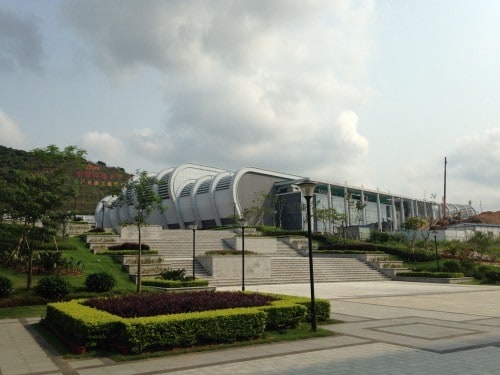
By Michael Banks in Dongguan, Guangdong province, China
Today I took the 60 km trip north from Shenzhen to Dongguan – home of the China Spallation Neutron Source (CSNS).
China has two nuclear reactors that generate neutrons for research via nuclear fission, but the CSNS is the country’s first spallation source. This type of facility accelerates protons before smashing them into a target to produce copious amounts of neutrons. They are then sent to numerous instruments that are used by researchers to study materials.
The CSNS was first mooted in 2001, with construction starting 10 years later. Set for first neutrons in October next year, construction is still ongoing, but there is already a large amount done on the vast 0.67 km2 site. The majority of the administrative buildings are finished as well as those that will house the 200 m linac and the 238 m-circumference synchrotron. Yet to be complete is the target station building that contains the target and instruments (shown in the image above).
The CSNS will be the largest scientific facility in China and its location was selected due to the support of Guangdong province, which has provided about half of the RMB 2.2bn (£230m) construction costs.
When the facility opens to users in 2020 it will include just three instruments: a powder diffractometer, a neutron reflectometer as well as a small angle diffractometer.
Yet the CSNS has space for a further 17, some of which are already in the design process such as an engineering instrument built together with the ISIS neutron spallation source in the UK.
While China does not have a large neutron-scattering community, it is growing thanks to a number of initiatives such as training courses on neutron science for researchers and students. In March 2013 a neutron-scattering group was created by the Chinese Physical Society.
Officials at the CSNS will be hoping that those plans pay off as a proposal has already been submitted to the Chinese Academy of Sciences to build the remaining instruments. Not only that but land has been set aside for the CSNS to have a second target station that would include even more instruments.



